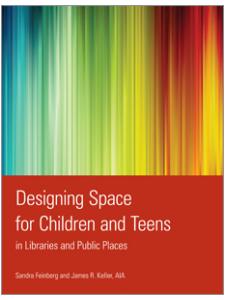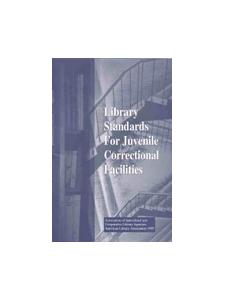Building Libraries & Library Additions: Specific Spaces in a Library
A selection of tools, resources, and advice to help you manage your library building project, whether large or small.
Resources for Children & Young Adults spaces
-
 Designing Space for Children and Teens in Libraries and Public Places
by
ISBN: 9780838910207Publication Date: 2010-05-01Providing tips, suggestions, and guidelines on the critical issues that surround designing spaces for children and teens, this how-to book will help you create a space that they will never want to leave. Whether your space is large or small, in a library or public place, this resource will give you creative and practical ideas for using the space to its full potential.
Designing Space for Children and Teens in Libraries and Public Places
by
ISBN: 9780838910207Publication Date: 2010-05-01Providing tips, suggestions, and guidelines on the critical issues that surround designing spaces for children and teens, this how-to book will help you create a space that they will never want to leave. Whether your space is large or small, in a library or public place, this resource will give you creative and practical ideas for using the space to its full potential. -
Libraries Designed for Kids by
ISBN: 9781555706319Publication Date: 2008-09-01Covers the complete planning process from concept to "grand opening." From the technical aspects of design and construction, to the finer points of lighting, acoustics, furnishings, equipment, and multimedia areas, storywells, YA spaces, and more. -
 Library Standards for Juvenile Correctional Facilities
by
ISBN: 9780838979884Publication Date: 1999Major socioeconomic changes and technological advances have affected American youth and library service. These standards explain how the library in a juvenile correctional facility must support, broaden, and strengthen the facility's total program of treatment and education.
Library Standards for Juvenile Correctional Facilities
by
ISBN: 9780838979884Publication Date: 1999Major socioeconomic changes and technological advances have affected American youth and library service. These standards explain how the library in a juvenile correctional facility must support, broaden, and strengthen the facility's total program of treatment and education. -
Make Room for Teens! by
ISBN: 9781591585664Publication Date: 2011-02-18This collection of thoughtful essays discusses library trends and best practices in creating dynamic, effective, and enjoyable spaces for young adults.
-
Teen Space on a DimeBlog post by Emily Brown, 14 April 2010. "Last November, armed only with a copy of Teen Spaces by Kimberly Bolan and a budget of $1,000, I set out to create a teen space in my library."
-
Teen Spaces by
ISBN: 9780838909690Publication Date: 2008-11-01This is a practical guide to revamping libraries to create spaces for teens. The book includes step-by-step instructions and easy-to-use templates, information on teen spaces policies, ways to involve teens in the space-renovation process, tools, worksheets, instructions, and vendor information, and much more.
-
Teen Space GuidelinesThese guidelines were created in 2011 -2012 by a task force of the Young Adult Library Services Association (YALSA) with feedback from the library community achieved through a public comment period in the fall of 2011. Members of the task force were Katherine Trouern-Trend (chair), Audrey Sumser, Kathy Mahoney, Caroline Aversano, Samantha Marker, and Kimberly Bolan Cullin. YALSA’s Board of Directors adopted the guidelines on May 24, 2012.
-
Teen Space Guidelines (PDF) These guidelines were created in 2011 -2012 by a task force of the Young Adult Library Services Association (YALSA) with feedback from the library community achieved through a public comment period in the fall of 2011. Members of the task force were Katherine Trouern-Trend (chair), Audrey Sumser, Kathy Mahoney, Caroline Aversano, Samantha Marker, and Kimberly Bolan Cullin. YALSA’s Board of Directors adopted the guidelines on May 24, 2012.
Resources for Adult & Senior spaces
-
Guidelines for Library and Information Services to Older Adults -RUSAThe American Library Association has a longstanding record of promoting library and information services to older adults. These guidelines, first developed in the 1970s, have been updated to respond to the changing demographics of an aging U.S. population.
-
It's Smart to Share Spaces - AARPMany nonprofit organizations, municipal offices and social service agencies can't afford to have their own buildings and facilities. One way to solve the problem, while also fostering community, is to share a location. Here, four places and programs that are happy to share.
-
Outreach Resources for Services to Older AdultsLibrary services to older adults represent a broad spectrum of traditional and innovative library practices. America’s older adults are diverse, differing by age, education, life experience, sexual orientation, health, geographic location, and income. To meet the needs of older adults, libraries need to develop innovative practices to meet the unique circumstances of the older population.
-
Planning the Modern Public Library Building by
ISBN: 9780313321559Publication Date: 2003-07-30See the section on "Creating a Senior-Friendly Library."
-
Senior Spaces: The Library Place for Baby Boomers, Older Adults & Their Families (PDF)The Old Bridge (NJ) Public Library has created an exciting and innovative approach to serving older adults by developing a little used space in the library. Building upon the success of this new “space,” the Library continues to develop programs and services to meet the changing needs of multi-generations of older adults and their families.
